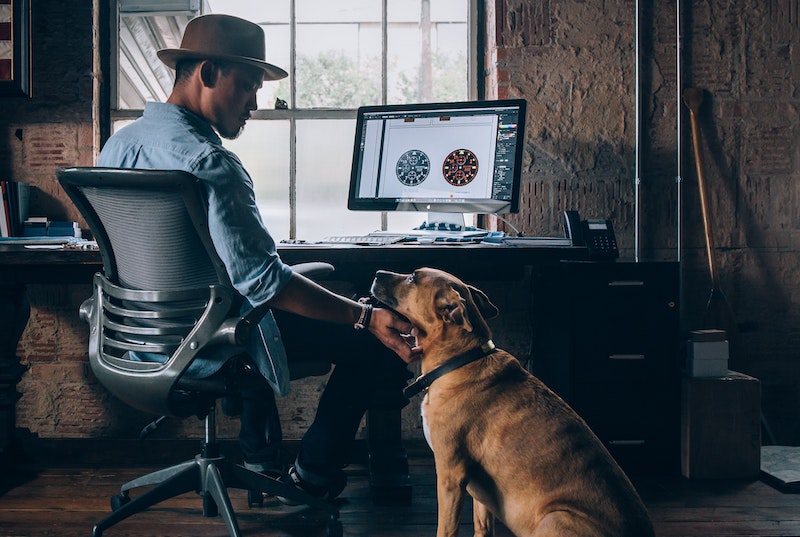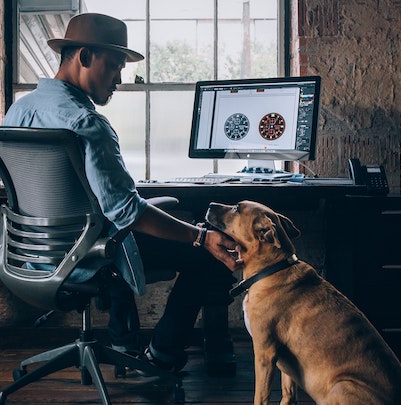
It’s hard to ignore the universal feeling of underlying anxiety now, and one place we can’t stop talking about it? Work. Whether you’re working from home, back in the office, or never left your work, the rules and how we feel about them have shifted.
The issue with work is, obviously, that we need it. While we’d all love to set our own boundaries, when it comes to paying the bills, most of us don’t have that choice. It’s one thing to tell your friends you don’t feel comfortable dining indoors, but telling your boss you don’t feel comfortable being in a conference room? That’s a little trickier.
Commuting on public transportation, sharing small office spaces, working with difficult customers, using the same kitchen space, worrying about whether your kids’ school will stay open, worrying about wearing a mask, worrying about not wearing a mask, worrying about everyone’s vaccination status, breakthrough cases, caring for at-risk elders, being immuno-compromised… these are just some of the areas that we’re sweating in this season of the pandemic.
Since we’re all holding our breath, literally and figuratively, here are some steps to take to manage that feeling of “ugh.”
1. Acknowledge what you’re feeling. And I don’t just mean, “I’m anxious,” but really sharing with yourself in writing what’s going through your head. Here’s an example:
“I’m nervous because I usually carpool, but do I want to be in a closed-space with other people? I know they’re vaccinated, but I still feel uncomfortable. I’m worried if I say that, my coworkers will take it personally, or they’ll think I’m paranoid. But I see my mom every week, and while she’s healthy, she’s 70 years old and I don’t want to take any risks. I asked my boss if I could work from home and she said she couldn’t make an exception. But I can’t be the only person feeling this way, can I?”
Dig into it. Share all your feelings. You need to get them out of your head so you handle them. The idea is not to come up with a solution, but to see where your anxiety is really stemming from. In that example, our friend is feeling lonely in her emotions. She’s worried no one will empathize with her. What she needs to do is connect with someone. That’ll take some vulnerability, but just having someone who shares her worries will help.
2. Decide what will make you feel safe, and then do as much of that as possible. Your safety, both physical and psychological, is so crucial to your mental wellbeing. This could look like wearing a mask where others aren’t, skipping that lunch in the busy restaurant, etc.
3. Keep routines that make you happy. If walks help you feel calm, schedule them into your day. If reading a book makes you feel better than scrolling social media, pick up the book. If you’re happier after you’ve connected with a friend, make sure to call them. Make what makes you feel good non-negotiable. I know, that can be difficult in practice, but here’s how I do it:
I draw out a calendar of the month by day. At the top of the sheet, I write a list of the things that make me happy. Then, on each day, I make sure to check off at least three items. For me, those items are: spend time with the animals, write for myself, get in a little exercise, enjoy a cup of coffee with a good book before work, stretch. I rarely ever do all of that in one day, but when I hit at least three in a day, I am noticeably calmer and happier.
Without that calendar, my days end up dedicated to work, laundry, dishes, and scrolling social media. And none of those are my happy place!
4. Build in a self-care practice. Happy habits are great, but they’re a little like watching TV when you’re sick. It’s nice, but it’s not curing the illness. If you’re really struggling with anxiety, try to do more than distract yourself. Make journaling a habit. Add 10 minutes of meditation to your day. Talk to a therapist or coach. Try our Braving Anxiety Journey. Treatment is different from treating yourself, and sometimes good treatment is what we really need. (And right now, a lot of us need it.)
As is always the saying in mental health, you’re not alone. And you truly aren’t. People are feeling this way across the globe in every work environment. Drop into our Anxiety Community and get some feelings off your chest. It helps, and sometimes a little help makes all the difference.

By Kelton Wright Vice President Content, Strategy and Production at Sanvello
Kelton is an author, editor, and athlete passionate about helping people live happier lives. She’s taught mindfulness to NFL coaches, led hundreds of women through cycling clinics, written an Amazon best seller on dating, and worked with brands like Runner’s World, Rapha, Headspace, Teen Vogue, Bicycling Magazine, Thrive Market, Skratch Labs, Peloton Magazine, and more all with the mission of empowering others. She is currently the VP of Content, Strategy, and Production at Sanvello. Follow her on Instagram: @keltonwrites.
